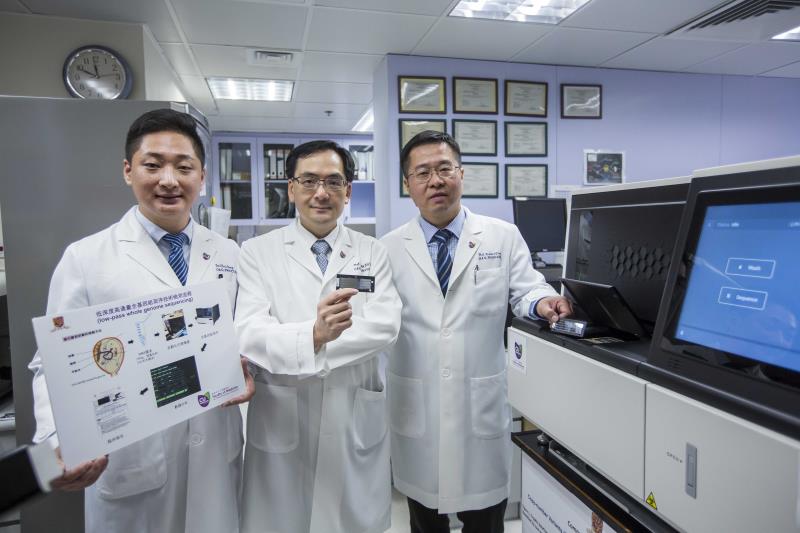 From left: Dr Elvis Dong, Prof Tak-Yeung Leung, Prof Richard Choy
From left: Dr Elvis Dong, Prof Tak-Yeung Leung, Prof Richard ChoyResearchers from the Department of Obstetrics and Gynaecology, Chinese University of Hong Kong (CUHK), have established low-pass genome sequencing (GS) as a valid prenatal invasive diagnostic technique with enhanced sensitivity and accuracy over conventional karyotyping and chromosomal microarray analyses (CMA), known as foetal DNA chip testing.
“Foetal DNA chip testing allows quick and thorough analysis of all chromosomes in a single test,” said Prof Richard Choy of the Department of Obstetrics and Gynaecology, CUHK. “However, it is highly reliant on the probe density of the target region. In the past 5 years, our team has developed and optimized genome-wide copy-number variant [CNV] analysis by utilizing low-pass whole GS with an in-house analytic pipeline, which reliably detects CNVs at higher resolution and provides additional cytogenetically relevant information compared with foetal DNA chip testing.”
Their prospective back-to-back study enrolled 1,023 pregnant women referred for prenatal genetic diagnosis between 2016 and 2019. After excluding maternal cell admixture and polyploidy by quantitative fluorescence polymerase chain reaction (QF-PCR) with short tandem repeat markers, samples from all 1,023 cases were independently and simultaneously subjected to low-pass GS and CMA platform for copy-number variant CNV analysis. [Genet Med 2019, doi: 10.1038/s41436-019-0634-7]
“Overall, our study demonstrated that low-pass GS provided a diagnostic yield of 13.5 percent [138/1,023], including all aneuploidies and pathogenic/likely pathogenic CNVs defined by CMA [11.8 percent] and 17 cases with additional diagnostic findings,” wrote the researchers.
Low-pass GS not only demonstrated advantage in identifying cryptic CNVs located in regions with insufficient probe coverage on CMA platforms, but also showed increased sensitivity in detecting low-level mosaicism.
In this study, after QF-PCR for each sample, amounts of DNA required for low-pass GS and CMA were set as 50 ng and 300 ng, respectively. “The significantly decreased amount of DNA required would make the testing of amniotic fluids possible in earlier gestational weeks, thus reducing parental anxiety,” noted the researchers.
The value of GS in prenatal studies was further demonstrated by identification of the Southeast Asian type α-thalassemia 19.3-kb homozygous deletion in 1.4 percent (14/1023) of cases, which is relevant, given the high prevalence of carriers in the South Chinese population. [Sci Rep 2017;7:920]
Five of the cases subjected to low-pass GS and 47 of the cases subjected to CMA failed the clinical quality control; thus, the experimental repeat rate of 0.5 percent (5/1023) for low-pass GS was significantly lower vs CMA (4.6 percent, 47/1023; p<0.0001). “Lower repeat rate in low-pass GS would decrease the experimental and labour costs compared with CMA, thus reducing the burden for clinical diagnostic laboratories,” commented the researchers.
“Our study demonstrates that the performance of CNV analysis in low-pass GS is equivalent and surpasses routine CMA in the context of prenatal diagnostic testing. Given a comparable turnaround time, higher throughput, and significant reduction in the technical repeat rate and amount of DNA required for the assay, our study provides compelling evidence for applying low-pass GS as an alternative prenatal diagnostic test,” concluded the researchers.